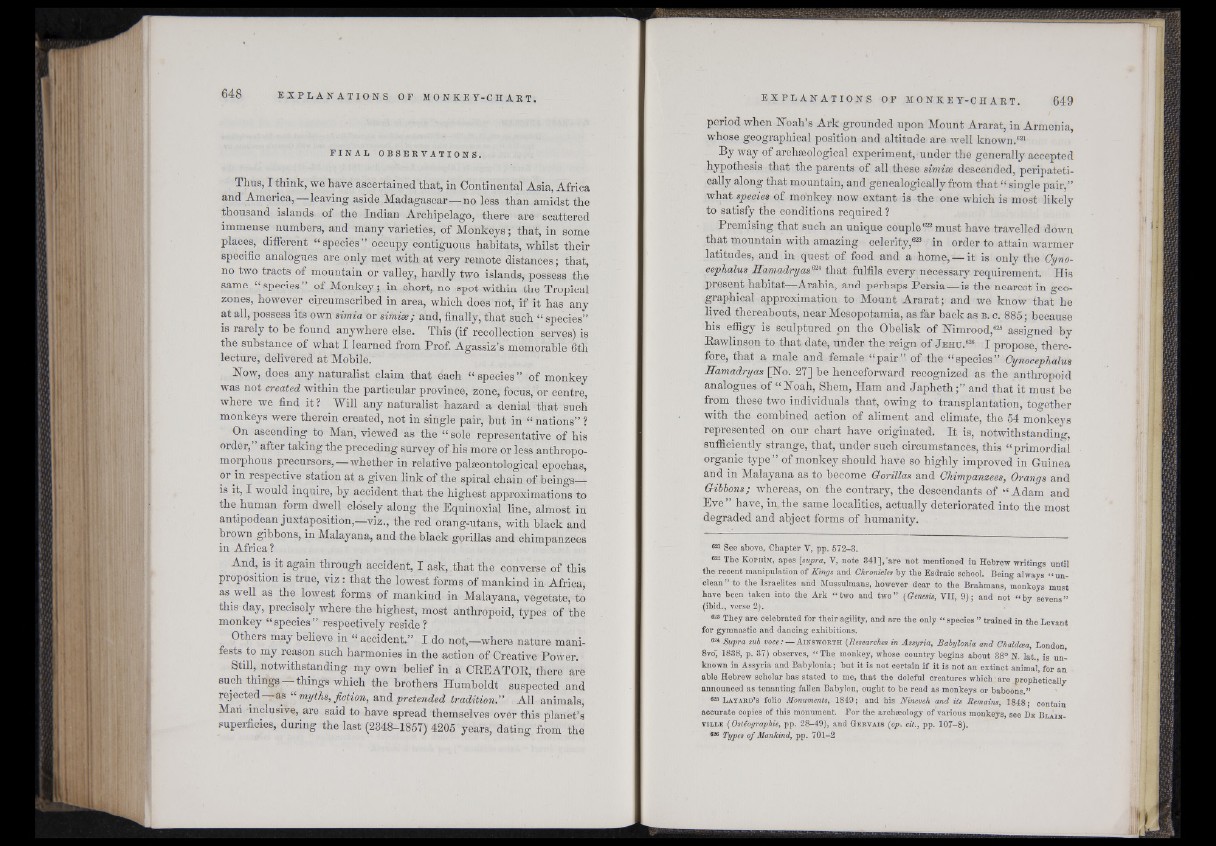
P I N A L O B S E E V A T I O N S .
Thus, I think, we have ascertained that, in Continental Asia, Africa
and America,—leaving aside Madagascar— no less than amidst the
thousand islands of the Indian Archipelago, there are scattered
immense^ numbers, and many varieties, of Monkeys; that, in some
places, different “ species” occupy contiguous habitats, whilst their
specific analogues are only met with at very remote distances; that,
no two tracts of mountain or valley, hardly two islands, possess the
same “ species of Monkey; in short, no spot within the Tropical
zones, however circumscribed in area, which does not, if it has any
at all, possess its own simia or sifnise; and, finally, that such P species”
is rarely to he found anywhere else. This (if recollection serves) is
the substance of what I learned from Prof. Agassiz’s memorable 6th
lecture, delivered at Mobile.'
How, does any naturalist claim that each “ species” of monkey
was not created within the particular province, zone, focus, or centre,
where we find it? Will any naturalist hazard a denial that such
monkeys were therein created, not in single pair, hut in “ nations” ?
On ascending to Man, viewed as the | sole representative of his
order, after taking the preceding survey of his more or less anthropomorphous
precursors,—whether in relative paleontological epochas,
or in respective station at a given link of the spiral chain of beings -
is it, I would inquire, by accident that the highest approximations to
the human form dwell closely along the Equinoxial line, almost in
antipodean juxtaposition,—viz., the red orang-utans, with black and
brown gibbons, in Malayana, and the black gorillas and chimpanzees
in Africa ?
And, is it again through accident, I ask, that the converse of this
proposition is true, v iz : that the lowest forms of mankind in Africa,
as well as the lowest forms of mankind in Malayana, vegetate, to
this day, precisely where the highest, most anthropoid, types of the
monkey “ species” respectively reside?
Others may believe in “ accident.” I do not,—where nature manifests
to my reason such harmonies in the action of Creative Power.
Still, notwithstanding my own belief in a CREATOR, there are
such things —things which the brothers Humboldt suspected and
rejected as “ myths, fiction, and pretended tradition.” .All animals,
Man inclusive, are said to have spread themselves over this planet’s
superficies, during the last (2348-1857) 4205 years, dating from the
period when Noah’s Ark grounded upon Mount Ararat, in Armenia,
whose geographical position and altitude are well known.621
By way of archaeological experiment, under the generally accepted
hypothesis that the parents of all these simiee descended, peripateti-
cally along that mountain, and genealogically from that “ single pair,”
what species of monkey now extant is tRe one which is most likely
to satisfy the conditions required ?
Premising that such an unique couple®2 must have travelled down
that mountain with amazing celerity,623 in order to attain warmer
latitudes, and in quest of food and a home, — it is only the Cyno-
cephalus Hamadryas624 that fulfils every necessary requirement. His
present habitat—Arabia, and perhaps Persia—is the nearest in geographical
approximation to Mount Ararat; and we know that he
lived thereabouts, near Mesopotamia, as far back as b . c. 885; because
his effigy is sculptured on the Obelisk of Nimrood,625 assigned by
Rawlinson to that date, under the reign of J e h u .626 I propose, therefore,
that a male and female “pair” of the “ species” Cynocephalus
Hamadryas [No. 27] be henceforward recognized as the anthropoid
analogues of “Noah, Shem, Ham and Japheth;” and that it must be
from these two individuals that, owing to transplantation, together
with the combined action of aliment and climate, the 54 monkeys
represented on our chart have originated. It is, notwithstanding,
sufficiently strange, that, under such circumstances, this “ primordial
organic type” of monkey should have so highly improved in Guinea
and in Malayana as to become Gorillas and Chimpanzees, Orangs and
Gibbons; whereas, on the contrary, the descendants of “ Adam and
Eve” have, in the same localities, actually deteriorated into the most
degraded and abject forms of humanity.
621 See above, Chapter V, pp. 572-3.
622 The Kophìm, apes [supra, V, note 341],’are not mentioned in Hebrew writings nnt.il
the recent manipulation of Kings and Chronicles by the Esdraio school. Being always “ unclean
” to the Israelites and Mussulmans, however dear to the Brahmans, monkeys must
have been taken into the Ark “ two and two” (Genesis, VII, 9); and not “ by sevens”
(ibid., verse 2).
62S They are celebrated for their agility, and are the only “ species ” trained in the Levant
for gymnastic and dancing exhibitions.
62‘ Supra sub voce: — Ainswoeth (Researches in Assyria, Babylonia and Chaliaia, London,
8vo] 1838, p. 37) observes, “ The monkey, whose country begins about 38° N. lat., is unknown
in Assyria and Babylonia; but it is not certain if it is not an extinct animal, for an
able Hebrew scholar has stated to me, that the doleful creatures which are prophetically
announced as tenanting fallen Babylon, ought to be read as monkeys or baboons.”
625 Latakd’s folio Monuments, 1849; and his Nineveh and its Remains, 1848- contain
accurate copies of this monument. For the archaeology of various monkeys, see De Blai.n-
v il l e (Ostéographie, pp. 28-49), and Geuvais (op. cit., pp. 107-8).
826 Types of Mankind, pp. 701—2